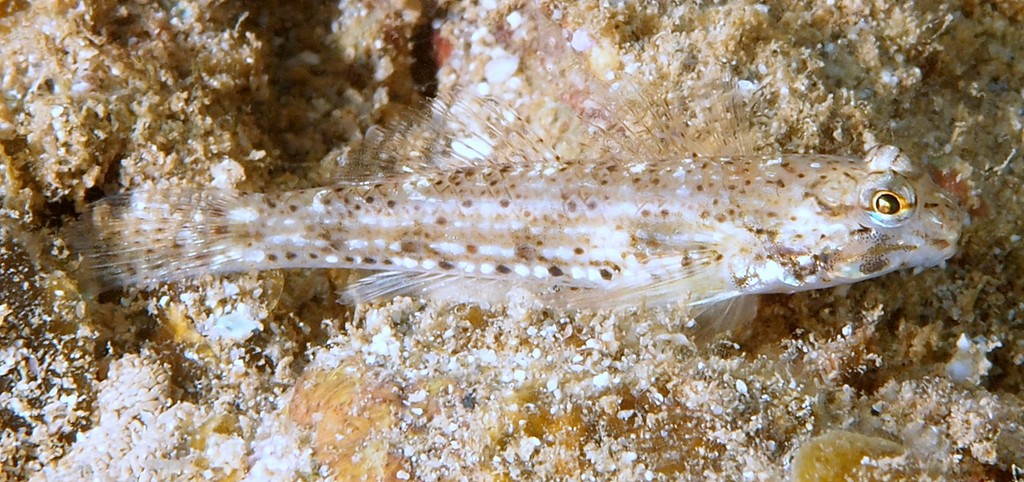ISTIGOBIUS GOLDMANNI - (BLEEKER, 1852)
Actinopterygii (Gigaclass) > Actinopteri (Class) > Teleostei (Subclass) > Gobiiformes (Order) > Gobioidei (Suborder) > Gobiidae (Family) > Gobiinae (Subfamily) > Istigobius (Genus)
Goldman's goby, Goldmann's sandy goby, Hime-kazarihaze,
Synonymes
Acentrogobius goldmanni (Bleeker, 1852)
Gobius goldmanni (Bleeker, 1852)
----------------------------------------------
Description
Dorsal spines (total): 7; Dorsal soft rays (total): 10-11; Anal spines: 1; Anal soft rays: 9 - 10; Vertebrae: 26. Upper pectoral fin rays entire. Nape with as many as 30 dark spots. A prominent diagonal, black line from posterior part of upper jaw to operculum. 4 broad, dark bands on abdomen; 2nd dorsal fin with 3-4 rows of black spots; pectoral fin clear, base with 2 small dusky spots. Predorsal cycloid scales 7-9, trunk ctenoid. In male, anal fin when appressed reaching almost the caudal fin; appressed 2nd dorsal fin overlapping caudal. Anal and 2nd dorsal fins of female when appressed reaching to within a distance of 2-3 scales of caudal fin. Max length : 6.0 cm (male ) - 4.7 cm (female). Depth range 1 - 10 m.
Etymology
Istigobius: Greek, istios = sail + Latin, gobius = gudgeon.
goldmanni: In honnor of the Governor of Moluques Islands Jonkheer C.-F. Goldman.
Original description: Gobius goldmanni Bleeker, 1852 - Locality type: Kupang, Timor, Indonesia.
Distribution
Western Pacific: Philippines to Fiji, north to Taiwan, south to northwestern Australia and southern Queensland. Recently recorded from Tonga. Reported from New Caledonia.
Biology
Found in sandy areas with both living coral and coral rubble, and from both moderately clear and turbid water. Genital papilla of male slightly pigmented, ending to side of anal spine. Female genital papilla truncate, ending well before origin of anal fin.
Similar species
Fishes in the genera Bathygobius can be easily confused with those of Istigobius. The main difference is the overhanging snout in Istigobius. Bathygobius has larger elongate dark spots on the midside and numerous small white spots (Istigobius has white lines, but no spots). Istigobius tends to have brighter colours, with Bathygobius being black, brown and white.
Goldman's goby, Goldmann's sandy goby, Hime-kazarihaze,
Synonymes
Acentrogobius goldmanni (Bleeker, 1852)
Gobius goldmanni (Bleeker, 1852)
----------------------------------------------
Description
Dorsal spines (total): 7; Dorsal soft rays (total): 10-11; Anal spines: 1; Anal soft rays: 9 - 10; Vertebrae: 26. Upper pectoral fin rays entire. Nape with as many as 30 dark spots. A prominent diagonal, black line from posterior part of upper jaw to operculum. 4 broad, dark bands on abdomen; 2nd dorsal fin with 3-4 rows of black spots; pectoral fin clear, base with 2 small dusky spots. Predorsal cycloid scales 7-9, trunk ctenoid. In male, anal fin when appressed reaching almost the caudal fin; appressed 2nd dorsal fin overlapping caudal. Anal and 2nd dorsal fins of female when appressed reaching to within a distance of 2-3 scales of caudal fin. Max length : 6.0 cm (male ) - 4.7 cm (female). Depth range 1 - 10 m.
Etymology
Istigobius: Greek, istios = sail + Latin, gobius = gudgeon.
goldmanni: In honnor of the Governor of Moluques Islands Jonkheer C.-F. Goldman.
Original description: Gobius goldmanni Bleeker, 1852 - Locality type: Kupang, Timor, Indonesia.
Distribution
Western Pacific: Philippines to Fiji, north to Taiwan, south to northwestern Australia and southern Queensland. Recently recorded from Tonga. Reported from New Caledonia.
Biology
Found in sandy areas with both living coral and coral rubble, and from both moderately clear and turbid water. Genital papilla of male slightly pigmented, ending to side of anal spine. Female genital papilla truncate, ending well before origin of anal fin.
Similar species
Fishes in the genera Bathygobius can be easily confused with those of Istigobius. The main difference is the overhanging snout in Istigobius. Bathygobius has larger elongate dark spots on the midside and numerous small white spots (Istigobius has white lines, but no spots). Istigobius tends to have brighter colours, with Bathygobius being black, brown and white.
